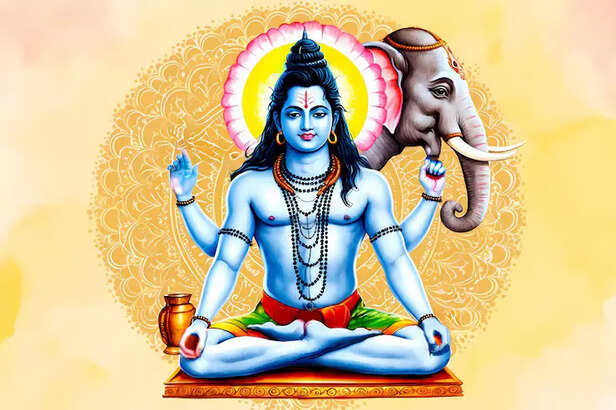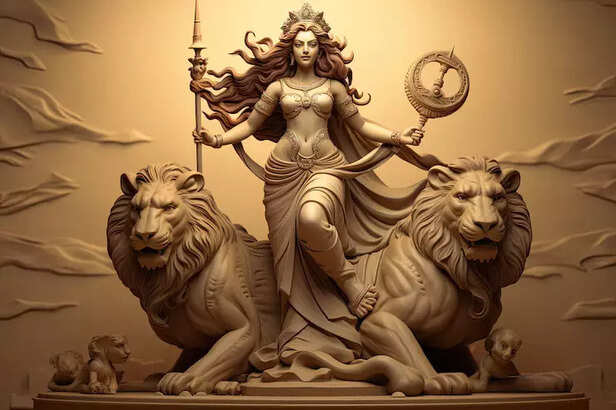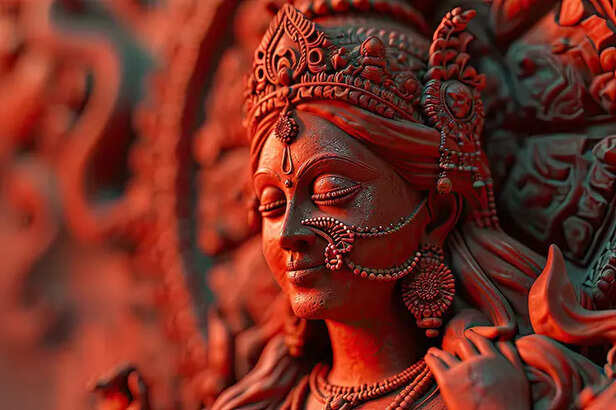What Hindu Gods Riding Animals Truly Signify
Amritansh Nayak | Jun 14, 2025, 14:15 IST
hindu gods
Hindu gods are often depicted riding animals—but these vahanas are far more than divine transportation. This article explores the symbolic, psychological, and ecological meanings behind these pairings, offering deep insight into how Hinduism connects nature, instinct, and inner mastery through sacred iconography.
In Hindu mythology, gods do more than merely walk or fly; they ride animals, each with its own symbolic meaning. These vehicles, known as vahanas, are powerful metaphors for inner attributes, natural forces, and cosmic order. Whether it's Ganesha's mouse, Shiva's bull, or Vishnu's eagle, each coupling conveys a story about power, control, and spiritual progress. This article dives into the deeper significance of these holy duos, explaining how Hinduism combines the natural world with the metaphysical, and how these symbols lead devotees to inner and outer harmony.

In Hinduism, Vahana literally means "that which carries" or "vehicle." However, it is much more than just a vehicle of transportation for deities; it represents a profound spiritual and philosophical bond between the divine and natural elements or the human psyche. Each deity's vahana is carefully selected to reflect their primary characteristics, functions, and energies. The vahana is both a sign of strength and a metaphor for the attributes that must be controlled or channeled. For example, Lord Shiva's vehicle, Nandi the bull, represents power, patience, and everlasting devotion.
Garuda, the great eagle that carries Lord Vishnu, symbolizes speed, might, and the ability to transcend the material world. Mooshak, the lowly mouse accompanying Lord Ganesha, represents the restless human mind and ego, implying that genuine knowledge rests in mastering even the smallest, most uncontrollable aspects of oneself. The god and their vahana form a full symbolic unit, with the divine element governing, elevating, or harmonizing the natural or instinctual power. Thus, vahanas are more than merely mythological accessories; they are crucial in portraying each deity's spiritual mission.

In Hindu iconography, the animal that each deity mounts is never chosen at random; rather, it is a strong metaphor for the traits that the divine has mastered or represents. These animals, or vahanas, represent raw, primal forces that, when channeled by the gods, reflect higher values and divine purpose. Garuda, the eagle that serves as Lord Vishnu's vehicle, denotes speed, vision, and control over the skies. His relationship with Vishnu represents the god's rapid protection and control over cosmic order. Nandi, the bull that accompanies Lord Shiva, represents power, stability, and calm endurance, emphasizing Shiva's meditative quiet in the midst of chaos. Mooshak, Lord Ganesha's tiny mouse, represents subtlety, quick intellect, and the capacity to navigate even the smallest corners of the world—qualities required to overcome hurdles.
Goddess Durga's lion or tiger, which represents fearlessness, might, and primordial energy, is less well-known but just as symbolic. Her act of riding this violent monster represents total control over hostility and the power to transmute destructive force into divine protection. Thus, the gods do more than just ride these creatures; they also govern them. This artwork serves as a reminder that spiritual progress necessitates taming our primal inclinations and channeling them into more purposeful existence.

Nature, according to ancient Indian philosophy, was a sacred extension of the divine rather than something to dominate. In this worldview, every tree, river, mountain, and animal held spiritual value. This strong regard for nature gave rise to the concept of vahanas, which depict gods riding on animals. Rather than elevating people above other beings, Hinduism incorporated ecological consciousness directly into its sacred structure. By linking gods with animals, Indian culture indirectly fostered respect and preservation for certain species. Worshiping Ganesha meant adoring the mouse, whereas venerating Vishnu meant respecting the eagle, Garuda.
These partnerships taught followers that animals were not lowly beings, but rather holy conduits of spiritual energy. This naturally generated a sense of coexistence and caring. The architecture of temples shows this regard. Lion, elephant, peacock, and serpent carvings are widespread, serving not only as ornament but also as spiritual emblems. Many temples include live animals in rituals, such as bulls in Shiva temples or elephants in processions, emphasizing their hallowed status. In an era of environmental crises, these ancient rituals send a timeless message: when nature is honored rather than ruled, harmony among all forms of life becomes not only possible—but divine.

Beyond mythology and symbolism, Hindu philosophy frequently views the vahana as a metaphor for the human ego, impulses, or mind—forces that must be subdued on the spiritual path. In this deeper view, the deity represents divine knowledge or wisdom, and the animal they ride represents the lesser impulses that may be dominated or conquered. A striking illustration is Lord Ganesha riding a mouse. The mouse, little but restless and crafty, symbolizes uncontrollable cravings, the wandering mind, or ego-driven urges. By riding on it, Ganesha demonstrates that true wisdom is found not in rejecting these tendencies, but in taming and leading them with awareness and purpose.
By riding on it, Ganesha demonstrates that true wisdom is found in mastering and leading these tendencies with awareness and purpose, rather than denying them. During rituals and devotion, worshippers are encouraged to internalize these symbols. The act of honoring the deity and their vahana becomes a mirror, prompting self-reflection: Are we ruled by our impulses, or have we learned to ride above them? In this way, vahanas offer a map to inner balance and self-mastery.
The vahanas of Hindu deities are far more than ornamental or legendary elements; they are mirrors of our inclinations, temperament, and spiritual aspirations. Each animal mate, whether representing personal mastery, ecological respect, or heavenly force, teaches followers a valuable lesson. Understanding these symbols provides insight not only into the gods, but also into the profound ideals of self-control, balance, and oneness with nature that are central to Hindu religion. The gods' journey ultimately serves as a roadmap for ours.
Explore the latest trends and tips in Health & Fitness, Travel, Life Hacks, Fashion & Beauty, and Relationships at Times Life!

Spiritual Symbolism of Vahanas
The concept of Vahana: More than just a ride
Garuda, the great eagle that carries Lord Vishnu, symbolizes speed, might, and the ability to transcend the material world. Mooshak, the lowly mouse accompanying Lord Ganesha, represents the restless human mind and ego, implying that genuine knowledge rests in mastering even the smallest, most uncontrollable aspects of oneself. The god and their vahana form a full symbolic unit, with the divine element governing, elevating, or harmonizing the natural or instinctual power. Thus, vahanas are more than merely mythological accessories; they are crucial in portraying each deity's spiritual mission.

maa durga
Power Embodied: What Each Animal Represents
Goddess Durga's lion or tiger, which represents fearlessness, might, and primordial energy, is less well-known but just as symbolic. Her act of riding this violent monster represents total control over hostility and the power to transmute destructive force into divine protection. Thus, the gods do more than just ride these creatures; they also govern them. This artwork serves as a reminder that spiritual progress necessitates taming our primal inclinations and channeling them into more purposeful existence.

Hinduism nature connection
Nature as a Divine Ally: An Ecological and Cultural Perspective
These partnerships taught followers that animals were not lowly beings, but rather holy conduits of spiritual energy. This naturally generated a sense of coexistence and caring. The architecture of temples shows this regard. Lion, elephant, peacock, and serpent carvings are widespread, serving not only as ornament but also as spiritual emblems. Many temples include live animals in rituals, such as bulls in Shiva temples or elephants in processions, emphasizing their hallowed status. In an era of environmental crises, these ancient rituals send a timeless message: when nature is honored rather than ruled, harmony among all forms of life becomes not only possible—but divine.

knowledge or wisdom
Inner journey: Vahana as the ego or mind.
By riding on it, Ganesha demonstrates that true wisdom is found in mastering and leading these tendencies with awareness and purpose, rather than denying them. During rituals and devotion, worshippers are encouraged to internalize these symbols. The act of honoring the deity and their vahana becomes a mirror, prompting self-reflection: Are we ruled by our impulses, or have we learned to ride above them? In this way, vahanas offer a map to inner balance and self-mastery.
The vahanas of Hindu deities are far more than ornamental or legendary elements; they are mirrors of our inclinations, temperament, and spiritual aspirations. Each animal mate, whether representing personal mastery, ecological respect, or heavenly force, teaches followers a valuable lesson. Understanding these symbols provides insight not only into the gods, but also into the profound ideals of self-control, balance, and oneness with nature that are central to Hindu religion. The gods' journey ultimately serves as a roadmap for ours.
Explore the latest trends and tips in Health & Fitness, Travel, Life Hacks, Fashion & Beauty, and Relationships at Times Life!
